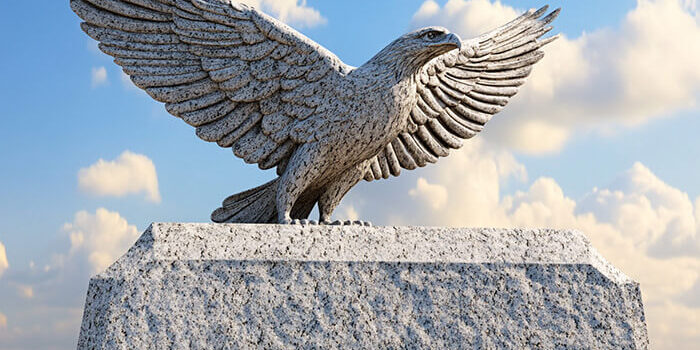The landing eagle on a headstone carries deep meaning in cemetery symbolism. This image appears on both military and civilian grave markers throughout American cemeteries. The design shows an eagle with its wings spread wide as it prepares to touch down.
On military headstones, the landing eagle represents the final homecoming of a service member. The eagle becomes the symbolic guardian of the fallen warrior’s spirit. This connection stems from the eagle’s role as a national symbol and its association with military service.
The United States military has strict rules about eagle designs on headstones. Veterans Affairs approves specific emblems for use on government-issued markers. The eagle must face right on these official stones, a tradition dating to the Civil War era.
Eagles on civilian headstones share some meanings with their military counterparts. The bird represents strength, courage, and freedom in these contexts. These qualities reflect the character traits families choose to remember about their loved ones.
The position of a landing eagle holds special significance. The descent suggests the soul’s return to earth after death. Some interpret this as the completion of life’s journey or the soul finding its final rest. The spread wings create a protective stance over the grave.
Christian interpretations link the landing eagle to religious themes. The eagle’s flight path mirrors the soul’s ascent to heaven. Biblical references to eagles strengthen these connections. The Book of Isaiah mentions those who “will soar on wings like eagles.”
Native American traditions view the landing eagle through different cultural lenses. Many tribes see eagles as messengers between the human world and the spirit realm. The landing posture represents this connection between earth and sky.
Masonic graves sometimes feature landing eagles with distinct symbolic elements. These eagles may hold arrows or olive branches in their talons. Such details reference deeper meanings within Masonic teachings about life, death, and immortality.
The artistic style of landing eagles evolved over time. Victorian-era stones show eagles with intricate feather detail. Modern markers tend toward simpler, bold designs. Each style reflects its period’s artistic preferences and stone-cutting techniques.
Cemetery historians study landing eagle variations across regions. Northern cemeteries favor formal, military-style eagles. Southern stones show more artistic freedom in eagle poses. Western markers blend multiple cultural influences in their eagle designs.
The size of landing eagles on headstones carries meaning. Large eagles dominate the stone’s face to show importance or authority. Smaller eagles may appear as part of larger scenes or symbolic groupings. Scale choices reflect both practical and symbolic considerations.
Material choice affects how landing eagles weather time. Granite eagles maintain sharp details longer than softer stones. Bronze eagles develop distinctive patinas. Marble eagles show age through subtle surface changes. Each material ages in unique ways.
The cost of landing eagle designs influenced their use. Complex eagle carvings required skilled stone workers. Simple eagle outlines cost less. Families chose designs based on their means. This economic factor shaped cemetery eagle populations.
Conservation efforts preserve historic eagle markers. Stone conservators clean and repair damaged eagles. They document original designs before wear erases details. Their work helps future generations understand these symbols.
Modern laser-cutting techniques changed eagle designs. New stones show precise, consistent eagles. Hand-carved variations disappeared. Technology standardized the landing eagle image across newer monuments.
Cemetery tourists seek out notable eagle markers. Photography groups document eagle styles. History buffs trace design evolution. This interest helps preserve knowledge about memorial art traditions.
The landing eagle continues as a popular choice for new headstones. Families connect with its timeless symbolism. The image bridges military and civilian memorial traditions. Its meaning resonates across cultural boundaries.
Understanding landing eagle symbolism enriches cemetery visits. The eagles tell stories about the deceased. They reflect American memorial traditions. Their presence adds depth to cemetery landscapes. This knowledge helps preserve and respect these meaningful monuments.







